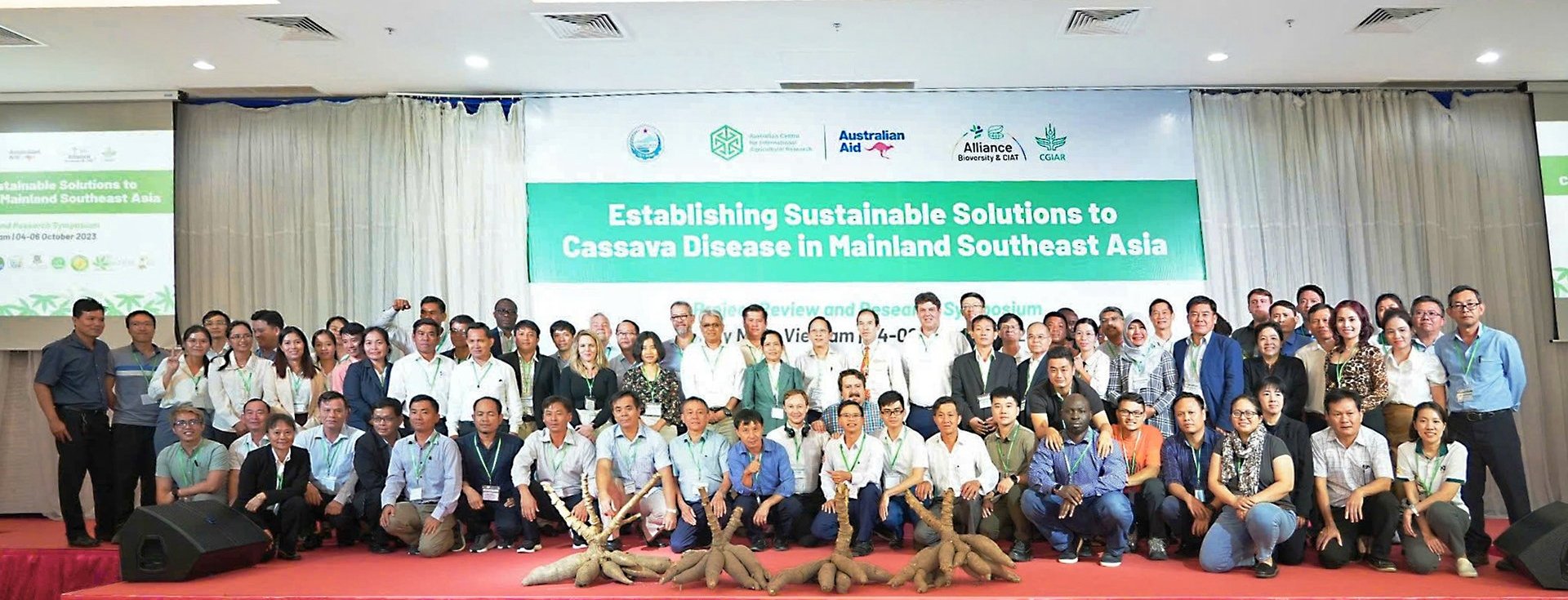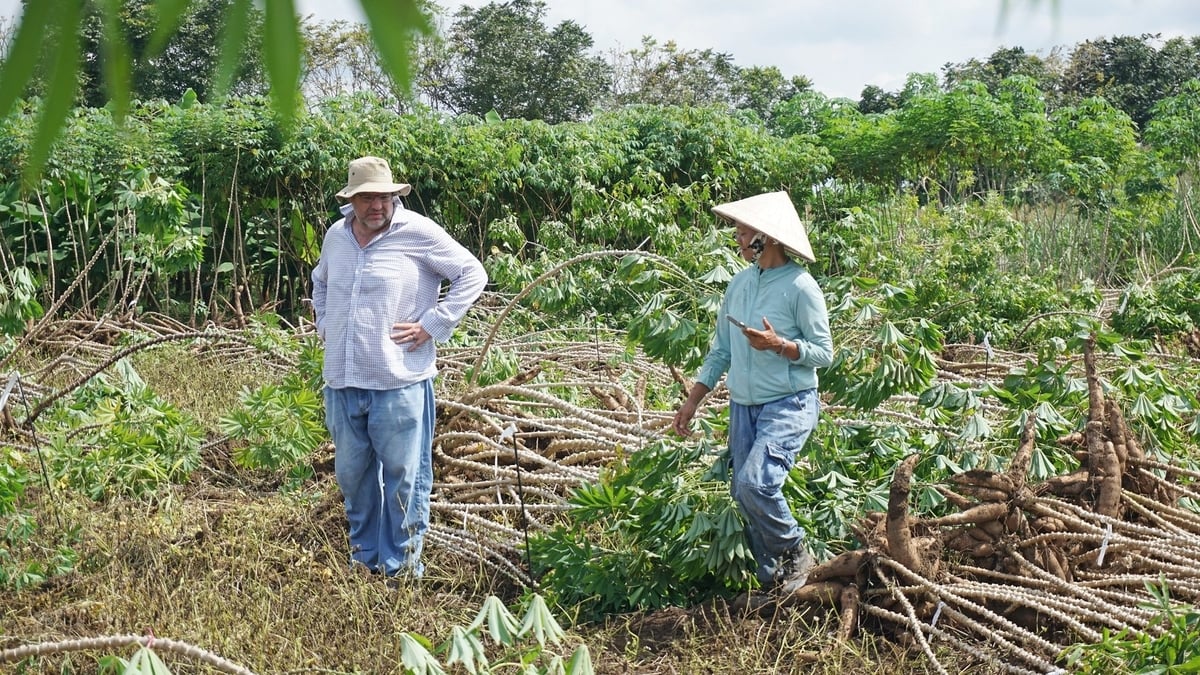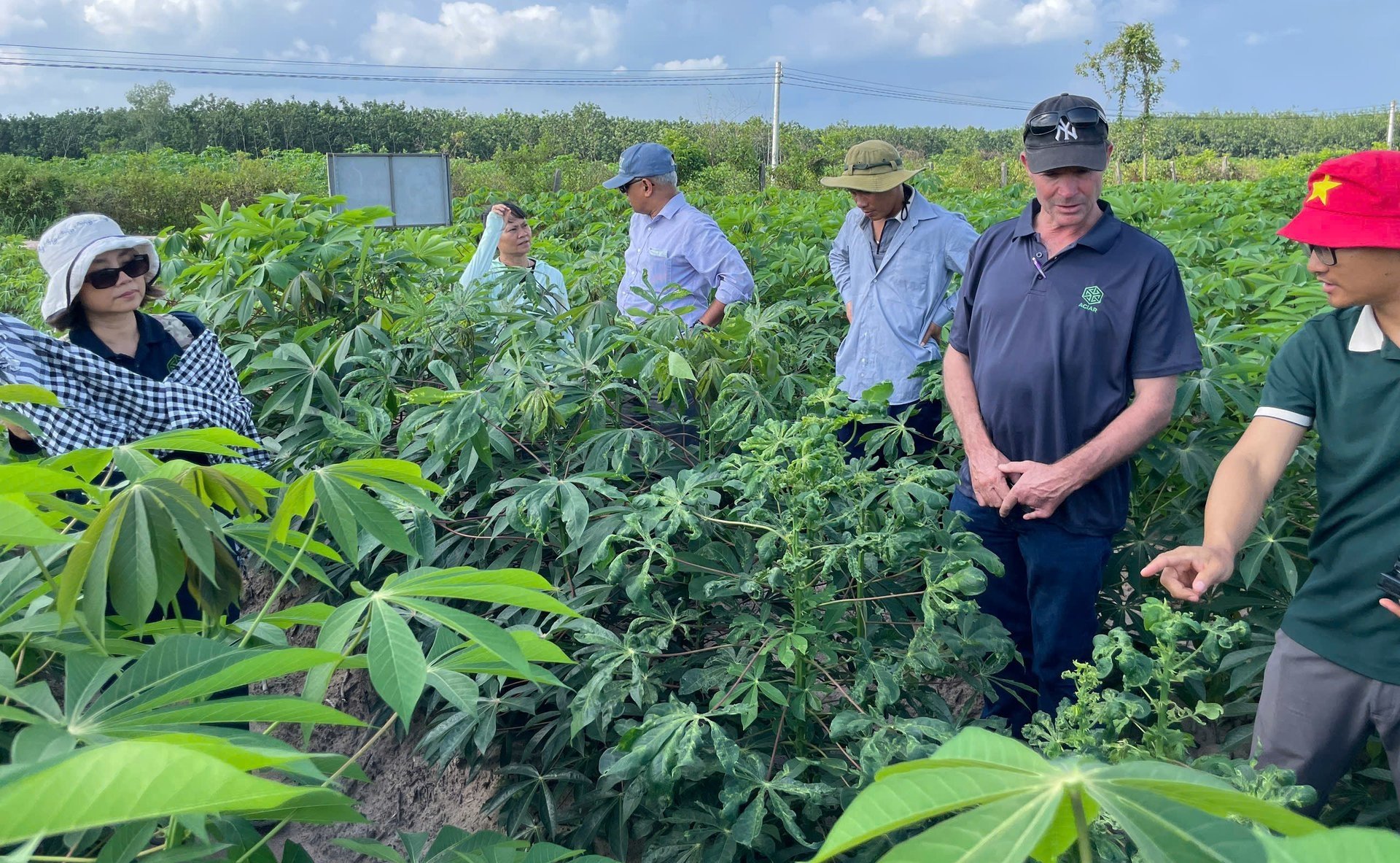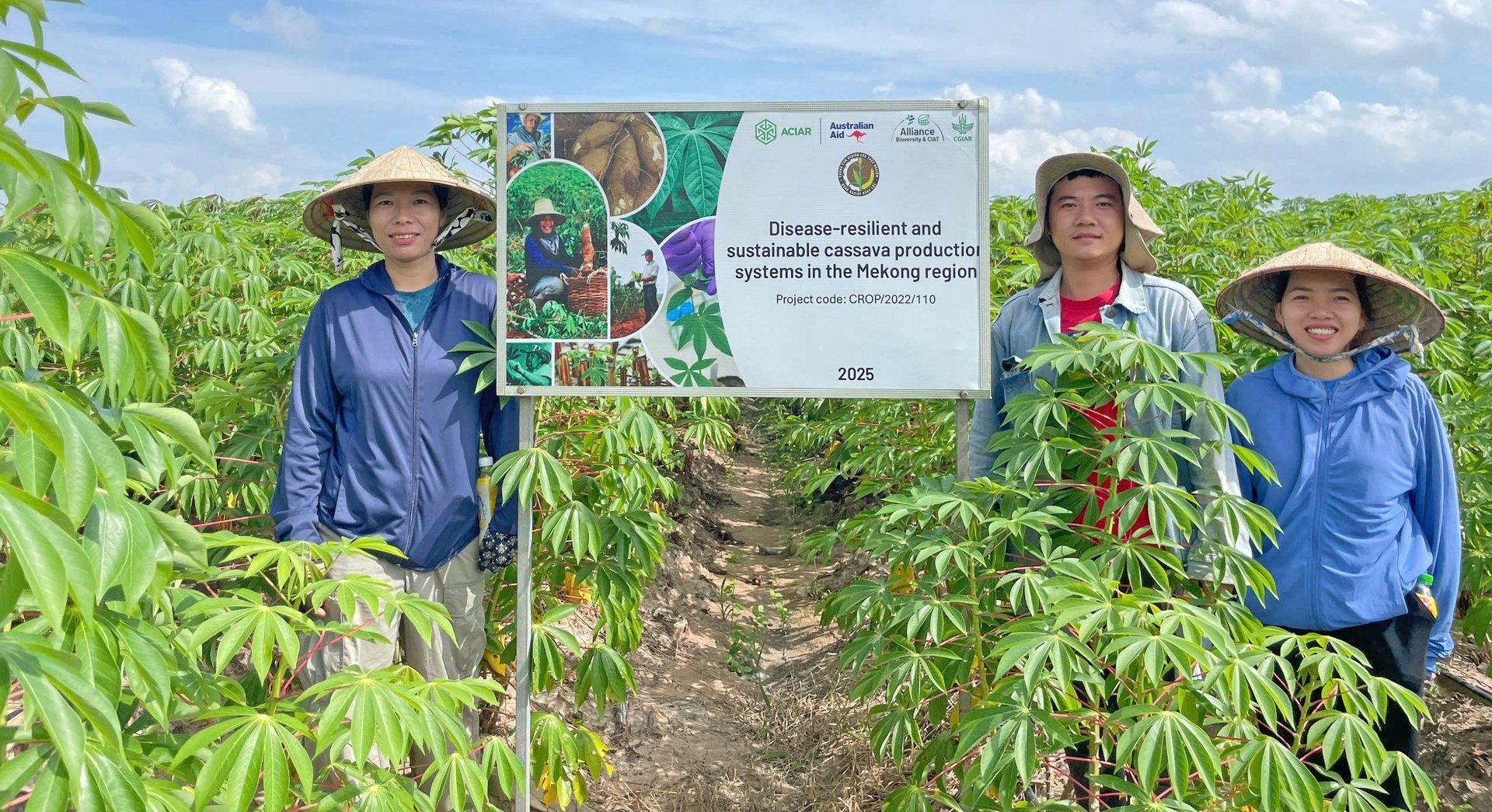December 30, 2025 | 15:14 GMT +7
December 30, 2025 | 15:14 GMT +7
Hotline: 0913.378.918
December 30, 2025 | 15:14 GMT +7
Hotline: 0913.378.918
Over the past three decades, through strategic and steadfast collaboration, the International Center for Tropical Agriculture (CIAT), as a research partner, and the Australian Centre for International Agricultural Research (ACIAR), as a donor, have played a pivotal role in transforming cassava in Vietnam from a low-value food crop into a billion-dollar export industry, laying a solid foundation for sustainable development in the future.

Delegates from CIAT, ACIAR, the Tay Ninh Department of Agriculture and Rural Development, and partner research institutes in Viet Nam, Laos, Cambodia, and Thailand attended the 2023 project completion workshop on "Establishing Sustainable Solutions for Cassava Disease in Mainland Southeast Asia" held in Tay Ninh province. Photo: Khanh Linh - CIAT.
Before the 1990s, cassava in Vietnam was mostly grown from local varieties such as Gon, Chuoi, Du, and Xanh Vinh Phu, which were primarily used for fresh consumption and small-scale animal feed. These varieties produced very low yields and starch content, averaging only 7 - 8 tonnes per hectare.
A historic turning point came in 1987 when Professor Kazuo Kawano, representing CIAT, signed the first cooperation agreement with the Institute of Tropical Biology, marking the start of Vietnam’s cassava breeding program. Shortly afterward, over 500 cassava hybrid lines from CIAT’s valuable genetic resources were brought to Vietnam for trials and evaluation at the Hung Loc Agricultural Experiment Research Centre (under the Southern Institute of Agricultural Science and Technology).
The program quickly expanded to involve a network of research institutes and universities across the country, forming Vietnam’s cassava research and technology transfer network.
The results of this collaboration amounted to a true revolution. Numerous elite cassava varieties provided by CIAT and bred by Vietnamese scientists were officially recognized for production, including KM60, SM937-26, KM98-1, KM98-7, Sa21-12, and KM101.
Particularly noteworthy was the KM94 variety, originating from CIAT/Colombia and introduced to Vietnam through an inter-Asian germplasm trial. KM94 became a legend, accounting for 40 - 50% of the cassava area in the South and 70 - 80% in the North, helping to boost the national average yield to over 20 tonnes per hectare, with some areas achieving 30–35 tonnes per hectare.
As a result, Vietnam, once a low-yield cassava producer, rose rapidly, with over 90% of its more than 500,000 hectares now planted with CIAT-origin varieties, contributing to stable export revenues of around USD 1 billion annually.
While the cassava sector was on an upward trajectory, new challenges emerged most notably the outbreak of serious pests and diseases. Since 2017, Cassava Mosaic Disease (CMD) has spread rapidly, causing severe damage.
In response, CIAT and Vietnamese research institutes, with crucial funding support from ACIAR, promptly launched the 2019 - 2024 project "Establishing Sustainable Solutions for Cassava Disease in Mainland Southeast Asia."

New cassava varieties with high yields, high starch content, and resistance to pests and diseases are being tested by experts from CIAT and the Hung Loc Agricultural Experiment Research Centre as part of the project in Dong Nai and Tay Ninh provinces. Photo: Ngoc Hung – HARC.
The project has enabled Vietnam to access disease-resistant genetic resources from CIAT/Colombia. After years of effort, scientists successfully bred and released cassava varieties with absolute resistance to Cassava Mosaic Disease, such as HN1 and HL-RS15, bringing great hope to farmers.
Moreover, ACIAR has continued to approve funding for CIAT and research institutions in Vietnam, Laos, and Cambodia to implement the 2023 - 2028 project “Sustainable and Pest-Resilient Cassava Production Systems in the Mekong Region.” The project aims to jointly build and enhance the cassava production value chain in the region in the coming years.
In addition to variety development, CIAT has also transferred advanced technologies such as rapid multiplication using in vitro techniques and tunnel greenhouses, which shorten the time to supply disease-free planting stakes to production by up to 15 times compared to traditional methods. Sustainable farming practices, such as intercropping and planting Vetiver grass to prevent soil erosion, have also been researched and widely promoted.

Experts from ACIAR, CIAT, and Vietnamese scientists discuss in the field, showcasing effective international collaboration in developing the cassava industry. Photo: Thu Huong - HARC.
The remarkable achievements from effective collaboration with CIAT and the practical support from ACIAR have created a strong scientific and practical foundation, helping to establish cassava as one of Vietnam’s strategic crops.
The clearest evidence of this importance came on April 17, 2024, when the Minister of Agriculture and Rural Development (now the Ministry of Agriculture and Environment) signed Decision No. 1115/QĐ-BNN-TT approving the "Sustainable Development Plan for the Cassava Industry to 2030, with a Vision to 2050."
The plan sets specific targets for 2030: maintaining the national cassava cultivation area at 480,000 - 510,000 hectares, with total fresh root production reaching 11.5 - 12.5 million tonnes. This decision not only reaffirms the sector’s position but also ushers in a new phase of development - one that demands stronger investment in science and technology, deep processing, and the building of sustainable value chains.
The more than 30-year journey of cooperation between Vietnam, CIAT, and donor partners such as ACIAR stands as a successful model of agricultural technology transfer and international collaboration. From the very first cassava varieties to advanced technological solutions, this partnership has helped transform the fate of a crop, secure livelihoods for millions of farmers, and make significant contributions to the national economy.

The cassava research team at the Hung Loc Agricultural Experiment Research Centre (Southern Institute of Agricultural Science and Technology), who is the main partner in CIAT and ACIAR research projects in Viet Nam. Photo: Thu Huong – HARC.
Building on the foundation of the "Sustainable Development Plan for Vietnam’s Cassava Industry to 2030, with a Vision to 2050," the country’s cassava sector is now presented with significant opportunities. The continued companionship of international partners such as CIAT and ACIAR will undoubtedly remain a valuable driving force, enabling Viet Nam to successfully achieve its strategic goals elevating the cassava industry to new heights of efficiency, sustainability, and global competitiveness.
Translated by Kieu Chi

(VAN) From extensive shrimp ponds, baskets of don gathered on the mudflats, to boats carrying visitors to watch birds, all livelihoods here depend on clean water, green forests, and the calls of migratory birds.
/2025/12/26/0703-3-204813_117.jpg)
(VAN) Transparency in information and listening to local people have helped address ground clearance bottlenecks and build social consensus, thereby accelerating the progress of the JICA3 irrigation project.
/2025/12/27/0609-3-233846_327.jpg)
(VAN) The JICA3 project is expected to become a 'water shield,' helping control saltwater intrusion, proactively secure water resources, protect livelihoods, and promote sustainable development in coastal areas.
/2025/12/26/5654-3-164509_655.jpg)
(VAN) As Viet Nam makes strong commitments toward achieving net-zero emissions, controlling and reducing methane emissions in livestock production is increasingly becoming a mandatory requirement.

(VAN) 'People, Primates, Plants: Co-managing Biodiversity and Improving Livelihoods in Vietnam' (the PPP Project) is an international initiative implemented in Vietnam by BGCI, CEGORN, and ICRAF/World Agroforestry.

(VAN) Dak Nong established a risk-level zoning map for coffee, built a digital data platform for the sector, and promoted certified production in line with EUDR.
/2025/12/25/2709-1-211551_295.jpg)
(VAN) In response to the U.S. Marine Mammal Protection Act (MMPA), Gia Lai province is implementing many solutions to protect marine mammals and develop sustainable, responsible fisheries.